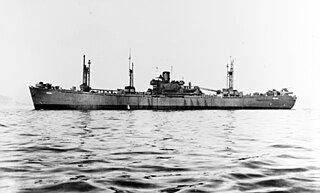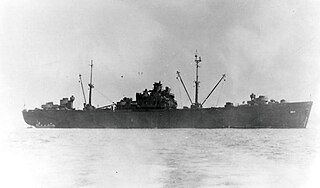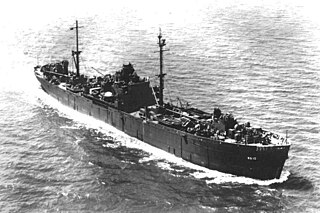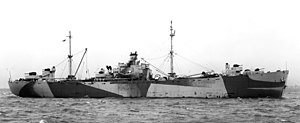
USS Naos (AK-105) was a Crater-class cargo ship commissioned by the US Navy for service in World War II. Naos was named after the star Naos, in the constellation Puppis. She was responsible for delivering troops, goods and equipment to locations in the Asiatic-Pacific Theater.
USS Hyperion (AK-107) was a Crater-class cargo ship in the service of the US Navy in World War II. Named after Saturn's moon Hyperion, she is the only ship of the Navy to bear this name.

USS Longshaw (DD-559), a Fletcher-class destroyer, was a ship of the United States Navy named for Dr. William Longshaw, Jr. (1836–1865), who served in the Navy and was killed during the Civil War.

USS Aulick (DD-569) was an American Fletcher-class destroyer, was the second ship of the United States Navy to be named for Commodore John H. Aulick (1787–1873).

USS Cetus (AK-77) was a Crater-class cargo ship in the service of the US Navy in World War II. Named after the equatorial constellation Cetus, it was the only ship of the Navy to bear this name.

USS Cebu (ARG-6) was a Luzon-class internal combustion engine repair ship that saw service in the United States Navy during World War II. Named after Cebu, an island in the Philippines, it was the second ship of the Navy to bear this name.

USS Sherburne (APA-205) was a US Navy Haskell-class attack transport, built and used during World War II. She was of the VC2-S-AP5 Victory ship design type. Sherburne was named for Sherburne County, Minnesota. She was later converted and renamed USS Range Sentinel (AGM-22), a missile range instrumentation ship.

USS Mifflin (APA-207) was a Haskell-class attack transport in service with the United States Navy from 1944 to 1946. She was scrapped in 1975.

USS Luzon (ARG-2) was an internal combustion engine repair ship in service with the United States Navy from 1943 to 1947 and from 1950 to 1960. She was the lead ship in a class of twelve ships and was scrapped in 1974.

USS Oahu (ARG-5) was a Luzon-class internal combustion engine repair ship that saw service in the United States Navy during World War II. Named for the Island of Oahu, third largest island in the Hawaiian chain, it was the second US Naval vessel to bear the name.

USS Mona Island (ARG-9) was Luzon-class internal combustion engine repair ship in service with the United States Navy from 1944 to 1947. She was sunk as an artificial reef in 1975.

USS Matar (AK-119) was a Crater-class cargo ship, converted from a Liberty Ship, commissioned by the US Navy for service in World War II. She was first named after Napoleon B. Broward, an American river pilot, captain, and politician; he was elected as the 19th Governor of the US state of Florida. She was renamed and commissioned after Matar, a binary star in the constellation of Pegasus. She was responsible for delivering troops, goods and equipment to locations in the war zone.

USS Azimech (AK-124) was a Crater-class cargo ship commissioned by the US Navy for service in World War II, named after the Azimech, the other name of Spica, the brightest star in constellation Virgo. She was responsible for delivering troops, goods and equipment to locations in the war zone.

USS Tutuila (ARG-4) was a Luzon-class internal combustion engine repair ship that saw service in the United States Navy during World War II, The Korean War, and The Vietnam War as well as several smaller actions. Named for the Island of Tutuila, the largest and main island of American Samoa, it was the second US Naval vessel to bear the name. After serving for nearly 30 years Tutuila was sold to the Republic of China in 1972.

USS Samar (ARG-11) was a Luzon class internal combustion engine repair ship that saw service in the United States Navy during the final days of World War II, and in the post-war period. Named for the Samar Island in the Philippines, it was the second U.S. Naval vessel to bear the name.

USS Palawan (ARG-10) was a Luzon class internal combustion engine repair ship that saw service in the United States Navy from 1945 to 1947. She was sunk as an artificial reef in 1977.

USS LST-451 was a United States Navy LST-1-class tank landing ship used in the Asiatic-Pacific Theater during World War II.
HMS LST-416 was as a Landing Ship, Tank Mk.2 of the Royal Navy during World War II. Built as a LST-1-class tank landing ship for the United States Navy, it was transferred to the British in 1943 and returned to US in 1946.
HMS LST-421 was a United States Navy LST-1-class tank landing ship that was transferred to the Royal Navy during World War II. As with many of her class, the ship was never named. Instead, she was referred to by her hull designation.

HMS LST-425 was a United States Navy LST-1-class tank landing ship that was transferred to the Royal Navy during World War II. As with many of her class, the ship was never named. Instead, she was referred to by her hull designation.


















